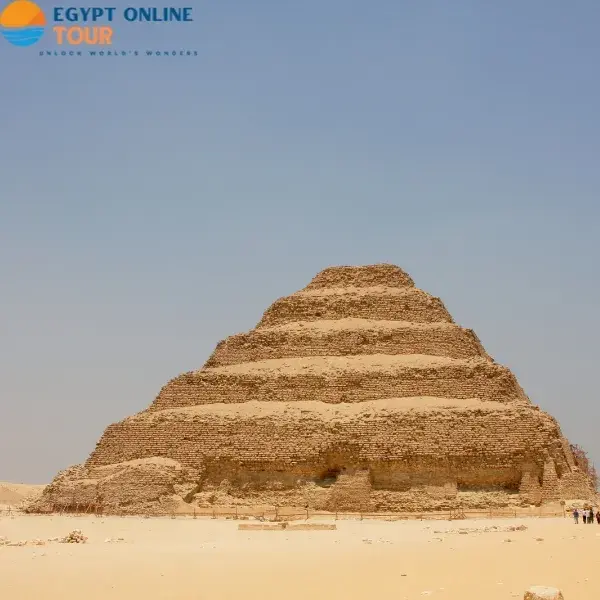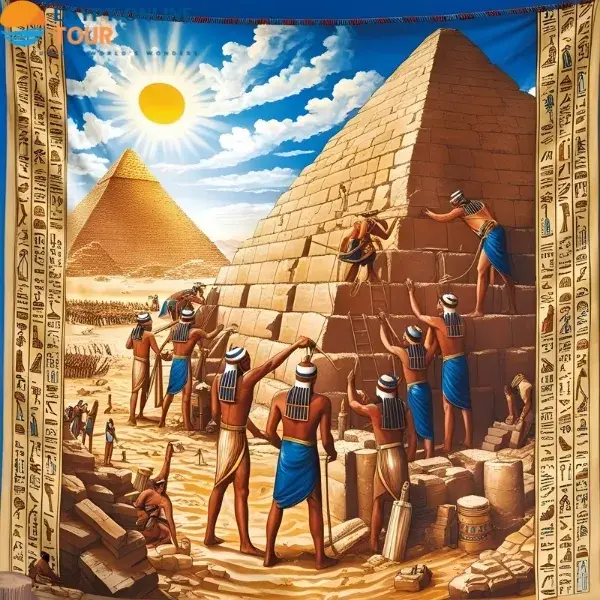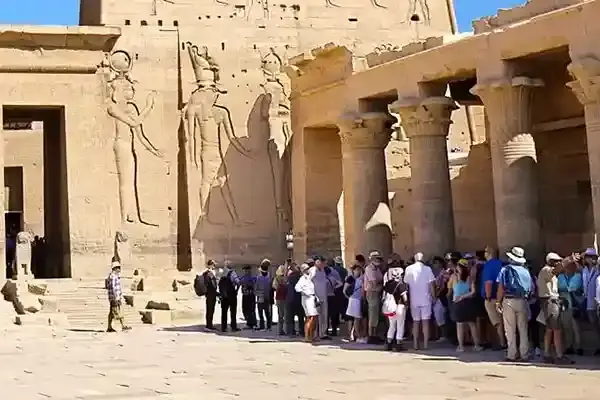Still asking yourself, "Why did the Egyptians build pyramids?" Maybe the better question is: how did they achieve such brilliance? If you’ve ever wondered when were the Great Pyramids built, this article reveals how ancient Egyptians combined engineering, astronomy, and architecture to create the Great Pyramid of Giza. You'll discover how its height changed over time and why it remains one of the most impressive structures in history. Stay with us to uncover its lasting secrets.
Still asking yourself, "Why did the Egyptians build pyramids?" Maybe the better question is: how did they achieve such brilliance? If you’ve ever wondered when were the Great Pyramids built, this article reveals how ancient Egyptians combined engineering, astronomy, and architecture to create the Great Pyramid of Giza. You'll discover how its height changed over time and why it remains one of the most impressive structures in history. Stay with us to uncover its lasting secrets.
Table of contents [Show]
- Why were the pyramids built?
- Egypt's first pyramid
- How old are the pyramids of Giza
- How long did it take to build the Great Pyramid of Giza
- When were the Great Pyramids built?
- How were the pyramids built?
- 2. Lifting Techniques: Internal and External Ramps
- Discover Egypt with Egypt Online Tour
- What are the pyramids in Egypt made of
- How tall was the Pyramid of Giza
- Conclusion
Why were the pyramids built?
Egyptian pyramids are one of the most impressive architectural achievements in human history. While they are monumental in their size and grandeur, there are various levels of religious, political, social, and technological meanings. Drawing on the available archaeological evidence and the work of Dr. Ahmed Fakhry, "The Egyptian Pyramids", allows some explorations take place about when and why they were built.
Egyptian pyramids have always been more than simple piles of stones. They are a representation of an ancient civilization's complex and often conflicting ideas of belief, power and technology. But why did Egyptians build pyramids? There is an answer based on archaeological evidence and corroborated by Egyptologist Dr. Ahmed Fakhry who he says pyramids were created as part of a spirit-driven construct related to an array of religious, political, social, and technological principles, ideas, and ways.
The pyramids Purpose
The pyramids were created not just as tombs but rather as spiritual engines. They were seen as machines which moved the souls of pharaoh's into eternal journeying into the afterlife.
Religious Purpose: The Ancient Egyptians believed that the pharaoh was divine and that a pyramid would help facilitate the ascension of their "soul" into the heavens. The upward, pointed shape of the pyramid was conceptualized as a ray of the sun, enhancing the ascent of the deceased king towards eternity.
Evidence:
- The Pyramid Texts, located inside the pyramids of the Fifth and Sixth Dynasties state rituals intended to help the king as they travels into the heavens.
- The burial chambers, solar boats (like those of Khufu), and symbolic items found within the pyramids support this purpose.
Besides their religious role, pyramids reflected royal power, national unity, and technological advancement.
- Political Power: Building such massive monuments showcased the centralized authority of the king, reinforcing his divine legitimacy.
- Social Role: Thousands of skilled laborers worked on these projects during the agricultural off-season, creating a sense of national purpose.
- Technological Innovation: The development from simple mastabas to full pyramids like those at Giza reflects centuries of architectural experimentation.
Egypt's pyramids were built for more than just burials; they embodied a belief in eternal life, state power, people's unity, and technological innovation. As Dr. Ahmed Fakhry writes, the pyramid was "a visible prayer in stone... rising toward the heavens, reaching for eternity.
You have to see this greatness yourself and see the inscriptions on the walls that explain the purpose of building the pyramids. Oh my God, it is a true miracle. Seize the opportunity now and book 15 Days Marvelous Tour Package in Egypt with Egypt On Line Tour, the best tourism company ever.
Read about: Did Thoth Built The Pyramids
Egypt's first pyramid
You're probably wondering about the first Egyptian pyramid. Let me tell you some truly interesting facts. The Step Pyramid of Djoser at Saqqara is considered the first massive stone pyramid in history, and the first successful attempt to transform royal tombs from a flat (mastaba) shape to a pyramidal structure. It was built in the 27th century BC during the Third Dynasty, designed by the architect Imhotep, who was later dubbed "the first architect in history" and later became an inspiration in Egyptian culture. Here are the details of its beginnings and the modern evidence supporting its importance:
from mastaba to step pyramid:
The transformation from mastaba to step pyramid. The pyramid began as a traditional square mastaba, then evolved into six stepped layers, 62.5 meters high, covered with a layer of shiny white limestone. Limestone was also widely used for the first time instead of mudbrick. Recent excavations have revealed that the pyramid underwent several expansions, starting from a base of 63 meters to a final height of 121 meters.
Recent evidence of construction techniques:
A study published in 2024 in the journal PLOS ONE suggested the use of a hydraulic system to lift stones. Analysis of the terrain around Saqqara indicates the presence of a dam (Gisr el-Mudir) designed to hold water and form a temporary lake west of the pyramid. The force of water was used to push stone blocks through volcanic-like channels within the pyramid, explaining the Egyptians' ability to lift massive stones without the need for traditional ramps. The "dry trench" surrounding the pyramid was also discovered, serving as a water treatment system with sedimentation and purification basins.
The complex underground design:
The pyramid includes a 5.5 km tunnel network containing more than 400 rooms, including Djoser's burial chamber. The 2021 mission discovered the remains of the pharaoh's granite sarcophagus and planned star decorations on the ceiling, but these were cancelled for an unknown reason. A carved chamber depicting Djoser performing the Heb-Sed ritual (a celebration of the renewal of kingship) was also discovered, confirming the religious rituals associated with the pyramid. 4. Recent archaeological discoveries, such as the Late Period mummies in 2021, when three mummies dating back to the Late Period (712–332 BC) were found inside the main burial chamber, indicating the pyramid's subsequent reuse as a burial site.
The Step Pyramid of Djoser is not just a tomb; it represents an architectural and social revolution that reflects the evolution of government control over resources and labor. Recent evidence, such as the hydraulic system and geotechnical analyses, demonstrates the Egyptians' engineering prowess, while archaeological discoveries confirm the site's continued importance for thousands of years. This pyramid represents the first building block of the "Age of Pyramids," which later reached its peak at Giza.
Book your 8 Days Pyramids & The Nile by Air to enjoy the greatest and first-of-its-kind vision of the historic leap in tomb architecture, the pyramid and the secret of the oldest pyramid in the world, with Egypt On Line Tour, the best tourism company in the world.

How old are the pyramids of Giza
The Pyramids of Khufu, Khafre, and Menkaure at Giza stand as iconic masterpieces of ancient Egypt’s architectural and engineering brilliance. They were built during the Old Kingdom during the Fourth Dynasty. Despite the passage of thousands of years, recent archaeological evidence strongly supports the approximate dates of the construction of these pyramids.
1. The Pyramid of Khufu (the Great Pyramid)
The estimated date of construction is specifically between 2580 and 2560 BC.
Current age:
- 4,584–4,604 years (considering a construction date of 2580 BC).
- 4,551–4,571 years (considering a construction date of 2551 BC).
In 2013, the Wadi al-Jarf papyri were discovered on the Red Sea coast, documenting the transportation of limestone blocks from Tura to the Giza site. They mention the leader of the responsible team, named "Merer," and confirm that these works were carried out by direct order of King Khufu. Radiocarbon analysis of organic materials found near the construction site also indicates results consistent with the reign of Khufu. According to Dr. Ahmed Fakhry, the design of the Great Pyramid was not only for burial purposes, but also a powerful symbol of Egyptian belief, as the pyramid was considered "a spiritual ladder by which the king ascended to heaven to live forever among the gods."
Take a look: Is the Sphinx Older Than the Pyramids
2. Pyramid of Khafre (Middle Pyramid)
The estimated date of construction is between 2520 and 2494 BC.
Current age:
- 4,514–4,544 years.
The famous Great Sphinx, carved from the rock near the pyramid, is believed to represent King Khafre, directly linking the pyramid to his reign. Furthermore, the design of the mortuary temple and valley temple demonstrates significant architectural development compared to the time of the construction of the Pyramid of Khufu, confirming the chronological order. Inscriptions on the tombs of officials adjacent to the pyramid bear names and titles dating back to Khafre's reign.
3. The Pyramid of Menkaure (the Small Pyramid)
Built between 2490 and 2472 BC, Current age 4,494–4,514 years., the lower part of the pyramid was lined with pink granite from Aswan, indicating the development of river transportation during that period. Inscriptions in the adjacent mortuary temple confirm the pyramid's lineage to King Menkaure and show the succession of rulers from Khafre to Menkaure.
The pyramids were not built haphazardly or under mysterious circumstances. Rather, their construction stages are documented by physical evidence, inscriptions, and papyri that are still being discovered today. This evidence confirms that the Giza pyramids were built during the 26th century BC, a time when Egypt reached the height of its civilization in terms of faith, organization, and architecture.
As Dr. Ahmed Fakhry said:
"The pyramid is not merely a tomb... it is an eternal idea embodied in stone, a symbol of the belief of a king who saw eternity as an extension of his rule."
This magnificence deserves to be seen more than a hundred thousand times, despite its great age. You will wonder how they achieved this creativity. Book your 12 Days Pyramids, Nile & Sinai Tour with Egypt Online Tour, the best provider of luxury trips in the world, and enjoy seeing the civilized world.
Maybe like to read: Strange Facts About The Pyramids

How long did it take to build the Great Pyramid of Giza
The construction of the Great Pyramid (Khufu's Pyramid) is believed to have taken between 20 and 27 years during the reign of King Khufu (c. 2580–2560 BC). Here is the precise historical, engineering, and archaeological evidence:
Historical Evidence:
- The Turin Royal Papyrus states that Khufu ruled between 23 and 27 years, the same period as the pyramid's construction.
- The Wadi al-Jarf Papyrus (discovered in 2013) is considered one of the most important archaeological discoveries of the 21st century, documenting precise details from the diaries of Merer, the supervisor of the transport of the Tura stones to Giza.
- The papyri show that the transport operations were still ongoing in the 27th year of Khufu's reign, confirming that the project continued until the end of his reign.
- The pyramid consists of approximately 2.3 million stone blocks, most of which weigh about 2.5 tons.
- If construction was carried out daily over 27 years, this translates to the transport and installation of approximately 800 blocks per day!
- The number of workers is estimated to have ranged between 20,000 and 25,000, according to renowned Egyptologist Mark Lehner, who asserts that they were professional laborers, not slaves, as was commonly believed in the past.
Organization was carried out through rotating work teams, ensuring the project's uninterrupted continuity.
Recent archaeological evidence:
- A study published in Nature in 2023 used radioactive isotope analysis to estimate the construction period. The result was conclusive:
"The pyramid was completed in 27 years, at a rate of 12 blocks per hour, assuming a 10-hour workday."
- A workers' town discovered next to the pyramid in 1990 revealed an integrated living system that included food, sleeping quarters, and even healthcare, indicating advanced project management.
- French engineer Jean-Pierre Houdin suggested that the Egyptians used an internal spiral ramp to lift blocks inside the pyramid, making construction faster and safer than traditional methods.
In 2017, archaeologists uncovered an ancient waterway beneath the Giza Plateau, thought to have helped move massive stones from Nile-side quarries, streamlining their transport to the pyramid site.
The Greek historian Herodotus said the pyramid was built over 20 years, but his statements came more than two thousand years after the event and relied on unverified oral accounts.
Radiocarbon analyses in the 1990s revealed earlier dates for the wood used, but scientists explained this by the Egyptians' use of recycled, ancient wood in construction.
Read about: How to Plan a Family Vacation in Egypt from USA
When were the Great Pyramids built?
The pyramids were built during the Old Kingdom of ancient Egypt, specifically during the period known as the "Age of the Pyramid Builders," from approximately 2700 BC to approximately 2200 BC.
Details of pyramid construction by period:
1. The Third Dynasty (c. 2700 BC):
During this period, the first true pyramid, the Step Pyramid of Djoser, was built in the Saqqara area by the architect Imhotep. This pyramid consisted of several terraces stacked on top of each other, hence its name, the "Step Pyramid." This pyramid is considered the beginning of the development of pyramid construction in Egypt. 2. The Fourth Dynasty (c. 2600-2500 BC):
This dynasty is known as the golden age of pyramid building, during which the greatest pyramids were built, such as:
The Pyramid of Khufu (the Great Pyramid)
The Great Pyramid (also known as the Pyramid of Cheops) was built between approximately 2580 and 2560 BC, during the reign of Pharaoh Khufu (or Cheops), the second king of the Fourth Dynasty of the Old Kingdom in Egypt. The precise dating is based on archaeological inscriptions, astronomical studies, and radiocarbon dating. According to the most common sources (such as the historian Manetho and Egyptologists):
- Construction began around 2580 BC.
- Construction was completed approximately 20 years later (c. 2560 BC).
Most estimates agree that the pyramid was completed before Khufu's death, to be his royal tomb. The Great Pyramid is an engineering feat that continues to baffle scholars with its precise construction methods. Despite the passage of thousands of years, it remains a testament to the development of Egyptian civilization and its organizational capabilities during the Early Dynastic Period.
Pyramid of Khafre (Middle Pyramid)
Khafre was one of the kings of the Fourth Dynasty. He was the son of King Khufu, during whose reign the Great Pyramid was built. He succeeded his brother Djedefre, and is considered one of the most important kings who completed the pyramid-building process. His hieroglyphic name, "Kha-Fre," was written "Kha-Fre," meaning "manifesting like Ra" (Ra is the ancient sun god).
The second largest pyramid at Giza
It was built around 2550 BC and is considered the second largest pyramid at Giza, although it sometimes appears taller than the Pyramid of Khufu due to its relatively high location on the plateau. Dr. Ahmed Fakhry stated that the Pyramid of Khafre is distinguished by its precise design, and that it appears taller than the Pyramid of Khufu, despite its smaller size, due to its construction on higher ground. He also pointed out that the Great Sphinx is an important testament to the Egyptians' sculptural skills, and that it likely dates back to the era of Khafre, based on archaeological evidence and nearby texts. He also asserted that Khafre's Valley Temple is one of the finest examples of Egyptian architecture and was used for royal funerary rituals.

What distinguishes the Pyramid of Khafre?
1 - The External Cladding:
- Part of the original stone cladding is still visible at the top of the pyramid, unlike the Pyramid of Khufu, which has completely lost its cladding.
- This demonstrates how smooth and seamless the pyramids originally were.
2 - Simple Interior Design:
- The passages within the pyramid are less complex than those in the Pyramid of Khufu.
- There is a descending passage leading to the burial chamber, built of red granite.
3 - The Presence of the Great Sphinx:
- The colossal Great Sphinx (a lion's body and a human head) is believed to have been carved during the reign of Khafre.
- It is located next to his pyramid and is thought to represent King Khafre himself.
4 - The Valley Temple:
- Next to the pyramid is the Valley Temple, one of the best-preserved funerary temples.
- It was built from massive blocks of pink granite from the Aswan quarries.
- It contains statues of King Khafre, some of the most beautiful sculptures in ancient Egypt.
Despite the passage of more than 4,500 years, Khafre's pyramid still stands strong, and the shape of the enclosure at its top is still clearly visible, demonstrating the ancient Egyptians' masterful planning and execution.
Pyramid of Menkaure (Smaller Pyramid)
King Menkaure, the son of King Khafre and grandson of Khufu, ruled at the end of the Fourth Dynasty, around 2530 BC. His hieroglyphic name, "Men-Ka-Re," means "Divine Spirit of Ra," reflecting the spiritual relationship between the king and the god Ra (the sun).
The Pyramid of Menkaure (also known as the Pyramid of Menkaure) is the smallest of the three main pyramids in the Giza pyramid complex. It was built at the end of the 26th century BC as a tomb for Pharaoh Menkaure (reigned c. 2532–2503 BC), the fifth king of the Fourth Dynasty, the son of King Khafre, and the grandson of Khufu.
It was completed around 2510 BC, with estimates indicating that work continued until the pharaoh's death, resulting in some parts of the funerary complex being unfinished.
Burial Chamber
The Pyramid of Menkaure is bordered on the northern side by a sloping tunnel, leading to an underground chamber overlooking an upper tunnel. The path leads directly to the center of the pyramid floor, where the burial chamber is located. This indicates that the sloping tunnel was part of the pre-planned plans for the Pyramid of Menkaure.
The Title of the Pyramid of Menkaure
The Pyramid of Menkaure was given the title of "the true pyramid" because it was built with smooth sides, unlike the pyramids that preceded it. The ancient Egyptians considered this a remarkable development in construction.
Although the Pyramid of Menkaure is smaller than the pyramids of Khafre and Khufu, it boasts the largest funerary temple among them on the Giza Plateau. On the northern side of the Pyramid of Menkaure is a longitudinal wound caused by an attempt to demolish the pyramid by King Al-Aziz Uthman ibn Saladin Yusuf in the 12th century. Fortunately, this attempt failed, but its impact on the Pyramid of Menkaure continues to this day.
Egypt Online Tours offers you the best Egypt Classic Tours and Luxury Egypt Tours packages and trips to the Pyramids. Book with us now.
How were the pyramids built?
The Egyptian pyramids—especially the Great Pyramid—remain one of the greatest engineering mysteries humanity has faced throughout the ages. Despite thousands of years, the latest scientific discoveries and modern technologies continue to reveal astonishing secrets about how these gigantic structures were built. Here are the most significant research findings up to 2025:
1. An Advanced Water System for Transporting Stones
- The Pyramids Branch - The Ancient Nile
In a study published in 2024, scientists discovered the existence of an extinct branch of the Nile River called the "Pyramids Branch," which extends 64 km and is believed to have been used to transport stones from quarries to the Giza Plateau via huge boats.
This discovery came after analyzing radar satellite images and the composition of the geological sediments in the area, strongly supporting the theory that the Nile was a vital artery for construction.
- Exploiting the Nile Flood
Inscriptions and studies indicate that the Egyptians exploited the annual Nile flood to create temporary waterways that reached the construction site directly, reducing the time and effort required for land transportation. Remains of these canals have already been found near the pyramids.
2. Lifting Techniques: Internal and External Ramps
- The Internal Helix Theory
French engineer Jean-Pierre Houdin proposed that workers used an internal helical ramp that gradually rose within the body of the pyramid itself. This idea is supported by the presence of geometric voids within the pyramid that may be remnants of this ramp.
- External Ramps
External stone ramps have also been found near smaller pyramids, such as the Pyramid of Djoser, indicating the use of straight ramps in the early stages. Although their application to the Pyramid of Khufu presents significant engineering challenges due to its massive size.
3. Innovative Hydraulic Techniques
- Water Lifting System
In a recent study in 2025, researchers proposed a water-pressure system for lifting heavy masses via internal water channels, similar to the techniques of lifting with hydro volcanoes. This technique was inferred from the discovery of a mysterious water column beneath the Pyramid of Djoser. Flood Control
Geological evidence indicates that the Egyptians constructed small dams (such as the Bridge Dam at Saqqara) to regulate the Nile's waters and direct them toward construction sites to provide a continuous working environment.
4. Labor Organization: Amazing Precision and Modern Management
- Skilled Workers, Not Slaves!
The discovery of construction workers' graves in 2010 containing inscriptions such as "Friends of Khufu" and "Lovers of the King" confirms that the workers received good medical care and food, dispelling the myth that they were slaves.
- Rotating Work Teams
The Wadi al-Jarf Papyri (2013) indicate that work was organized into specialized teams, each tasked with a specific task, such as cutting or transporting stones or constructing ramps. The flood season was utilized with maximum efficiency. 5. Modern Scientific Techniques Reveal Secrets
- Cosmic Muon Particles
In 2016, researchers from Nagoya University in Japan used cosmic muon particle technology to scan the Great Pyramid, discovering huge voids within the pyramid that may be hidden rooms or geometric passages.
- 3D Laser and Aircraft Scanning
LIDAR and drone technologies have contributed to the precise geometric mapping of the pyramids, revealing an error rate of no more than 0.05% in the angles, a surprise to modern engineers!
- Geopolymer Concrete Theory
French scientist Joseph Davidovits proposed that the stones were chemically manufactured using a mixture of clay and crushed limestone and poured into molds. However, most archaeologists reject this hypothesis due to the lack of casting tools or clear evidence of this.
- Astronomical Theories
Some researchers have linked the location of the pyramids to the stars in the Orion Belt, but astronomical studies confirm that the coincidence may be merely a geometric coincidence.
“The pyramids were built with intelligence, not just strength, but with scientific management centuries ahead of their time.” – Dr. Mark Lehner, American archaeologist
Read more: How to Enjoy A Luxury Vacation in Egypt
Discover Egypt with Egypt Online Tour
At Egypt Online Tour, we’re more than a travel company—we’re your local experts in creating unforgettable journeys through the heart of Egypt. With years of experience and a passion for showcasing the wonders of our country, we make every moment of your trip count.
🌍 What We Offer
🏛️ Tailored Egypt Tour Packages
Explore Egypt’s ancient treasures with our handpicked Egypt tour packages. From Cairo’s iconic pyramids to the temples of Luxor and Aswan, we design every detail to give you a smooth, immersive experience.
🌞 2027 Solar Eclipse Experience
Be part of a once-in-a-lifetime celestial event with our exclusive
Egypt Solar Eclipse 2027 tours. Witness this rare moment from the land of the pharaohs—an unforgettable combination of history and astronomy.
🏖️ Flexible Vacation Packages
Need a break? Our customizable Egypt vacation packages are perfect for honeymoons, family trips, or relaxing escapes—built to match your schedule, interests, and budget.

What are the pyramids in Egypt made of
When we stand before the pyramids, we don't just see a pile of stones; we witness a silent testament to the ingenuity of the ancient Egyptians. These monuments were not built in a vacuum; rather, each material was carefully selected to perform a specific function and in harmony with the nature and environment around them.
In light of the latest archaeological studies and geological analyses, we have a deeper understanding of what the ancients used in constructing this immortal achievement.
1. Limestone
The bulk of the limestone was extracted from the Giza Plateau itself, forming the solid core of the pyramid.
The bright white stone that encased the pyramid's exterior was brought from the Tura quarries on the east bank of the Nile.
In 2012, researchers discovered incomplete terraces in Tura that had the same dimensions as the cladding of the Great Pyramid of Khufu. Chemical isotope analysis in 2023 confirmed the identical composition of the Tura limestone to the remains of the cladding found at the base of the pyramid.
2. Granite
It was transported from the quarries of Aswan, more than 800 km to the south, where hard pink granite is found. It was used in:
- Inner chambers, such as the King's Chamber.
- Columns and ceilings inside funerary temples.
The Unfinished Obelisk in Aswan offers clear evidence of how ancient Egyptians extracted granite, while a 2021 study uncovered remnants of copper tools mixed with fine quartz grains—highlighting their astonishing precision in shaping hard stone.
3. Basalt
For a hard, time-resistant floor, it was quarried in the nearby Fayoum region and was used to cover the floors of nearby temples, such as the Temple of Khafre. Basalt floors still exist, showing natural cracks caused by earthquakes, indicating their antiquity and continuity.
4. Mud and Mud Brick
It was sourced from Nile silt mixed with straw. It was used for temporary ramps that helped lift stones and also in the construction of brick pyramids during later periods (such as the Lahun Pyramids).
In 2018, clay slopes in Dahshur were found bearing handprints of workers. A chemical analysis in 2020 revealed plant remains of wheat and barley inside the bricks.
5. Mortar
It consists of lime and volcanic ash or gypsum, and in some cases, adhesive clay was used.
A study published in Science in 2018 used X-ray fluorescence (XRF) and showed that the mortar was rich in calcium and silica. Plant fibers were also discovered within it, suggesting they were used to improve flexibility and prevent cracking.
Geopolymer Concrete Theory:
Postulated by the French scientist Joseph Davidovits, it states that the stones were cast from a mixture of lime and clay. However, a computed tomography (CT) study published in 2022 proved that the crystals within the blocks were natural, negating the manufacturing hypothesis.
Imported Wood:
The role of Lebanese cedar wood in building tools and solar boats cannot be ignored. A 2019 genetic study proved that the wood discovered in Khufu's boat actually originated in the mountains of Lebanon.
Latest Scientific Discoveries (2023–2024) on Pyramid Construction
ScanPyramids Project:
Using cosmic muon particles, unknown voids were revealed inside the Khufu Pyramid, possibly containing tools or rooms yet to be discovered.
Ancient DNA Analysis:
In 2023, fossilized bacteria were discovered in the mortar that aided hardening, which may explain the building's stability over thousands of years.
The ancient Egyptians didn't need extraordinary techniques to build the pyramids; they used whatever was available in their environment, including stone, clay, water, and even natural bacteria. Over time, modern analyses prove that every detail in the pyramid was calculated, carefully selected, and constructed with a human mind ahead of its time.
Every stone in the pyramid tells a story, and every modern scientific analysis brings us closer to a secret that has long fascinated the world... the secret of building the pyramids.
Perhaps touching these materials with your hands will be the best feeling ever. Book now for Egypt Budget Tours and enjoy watching the beauty of historical grandeur.

How tall was the Pyramid of Giza
The Great Pyramid of Giza has stood tall for thousands of years, one of the greatest engineering achievements in human history. Although it continues to amaze visitors from all over the world, what we see today is very different from the original version built by the ancient Egyptians during the reign of Pharaoh Khufu. Did you know that the pyramid was once taller than it is today? In fact, it was the tallest in the world for 3,800 years!
Original Height: 146.6 meters of precision and magnificence
Recent archaeological studies indicate that the original height of the Great Pyramid was 146.6 meters (about 481 feet). This number was far from random.
In 2013, the Wadi al-Jarf Papyrus was discovered, documenting the ancient Egyptians' use of precise units of measurement, such as the royal cubit (equivalent to approximately 0.523 meters). These papyri have supported archaeologists' calculations regarding the precise dimensions of the pyramid. An analysis of the pyramid's original angle of inclination (51°50'40") and the perimeter of the base, which measures 230.33 meters, proves that the engineering design was deliberate to achieve this height.
Current height: only 138.5 meters... Where did the rest go?
In 2025, the pyramid's current height is estimated at 138.5 meters, approximately 8 meters lower than its original height. Some sources cite a figure closer to 137 meters.
What is the reason?
The most important reason is the loss of the polished outer cladding layer, which was made of white limestone extracted from the Tura quarries on the east bank of the Nile.
During the Middle Ages, thousands of blocks were removed for use in the construction of mosques and palaces in Cairo.
Natural erosion (wind, rain, earthquakes) also played a role in eroding the upper layers of the pyramid.
Recent studies using lasers and 3D imaging technologies (such as the ScanPyramids project) have accurately revealed the extent of the change in the pyramid's height and the thickness of the missing cladding.
Khafre's Pyramid
Khafre's Pyramid: 143.5 meters at construction – now 136.4 meters
- Built immediately after the Great Pyramid, its original height was 143.5 meters, just three meters lower than the Pyramid of Khufu.
- What distinguishes Khafre's is that it still retains part of its original cladding at the top, giving us a visual sense of what the Great Pyramid would have looked like in its glory.
- Its current height is estimated at 136.4 meters, about 7 meters lower than its larger sibling.
Menkaure's Pyramid
Menkaure's Pyramid: Only 65.5 meters, but no less significant
- The smallest of the Giza pyramids, it was built to a height of 65.5 meters and now stands at about 61 meters.
- Despite its smaller size, its construction style demonstrates a unique engineering development, as pink granite from Aswan was used to clad the lower portion, in a design different from the other two pyramids.
Remains of cladding stones have been discovered at the base of the Great Pyramid and in the valley temple adjacent to the Pyramid of Menkaure. Khafre, indicating that the outer layer was approximately 2.5 meters thick.
The Unfinished Obelisk at Aswan also demonstrates how granite was quarried and cut with extreme precision, reflecting an amazing ability to control size and materials.
The Great Pyramids
Did you know that the Great Pyramid was the tallest man-made structure for 3,800 years? No other structure surpassed it until 1311, when Lincoln Cathedral in England was completed. Even compared to the Eiffel Tower (without its antenna), the pyramid would still be taller had it remained at its full original height.
The Great Pyramid is tilted from the cardinal directions (north, south, east, and west) by only 0.05 degrees!
While time and human influence have affected its appearance, recent archaeological evidence, such as the Wadi al-Jarf Papyri, laser scanning techniques, and analysis of stone remains, have reconstructed an accurate picture of what this magnificent edifice looked like in its heyday. Its glory.
Despite the loss of approximately 8 meters from its top, the Great Pyramid remains an enduring symbol of ancient Egyptian ingenuity... one that continues to baffle scientists and inspire the world to this day.
No matter how accurate the description is, it will not compare to seeing it in reality. Book your trip now with Egypt Online Tour for a 9-Day Tour of Cairo, Luxor, and Aswan and enjoy exploring history and civilization.
Conclusion
All of these achievements were accomplished more than 4,500 years ago, without modern equipment or advanced software, but rather with exceptional minds and simple tools.
Ultimately, the Great Pyramid remains an eternal testament to the genius of the pharaohs, which continues to amaze us and invite us to reconsider everything we thought possible or impossible in the world of construction and engineering.
Do you still doubt that the pharaohs were thousands of years ahead of their time?
Frequently Asked Questions
1 Why were pyramids built like a triangle? ▶
2 Why did Egypt not restore the pyramids? ▶
3 Who was forced to build the pyramids? ▶
Popular Categories
Related properties
Cairo, Aswan, and Luxor
-
Precio
$ 2,850
-
Tipo
Package
Cairo, Aswan, and Luxor
-
Precio
$ 1,850
-
Tipo
Package











